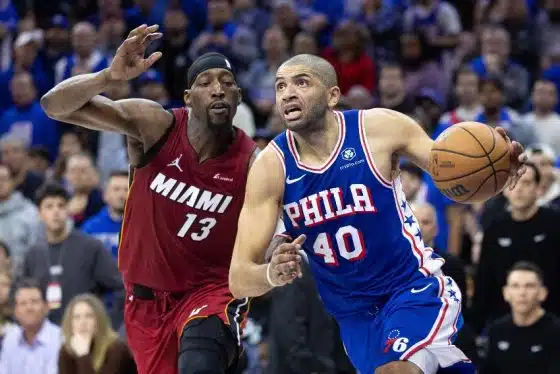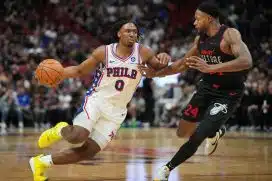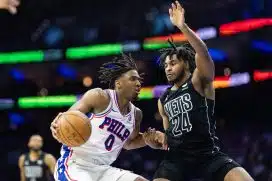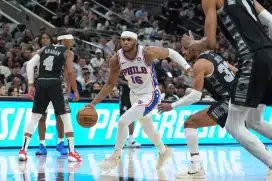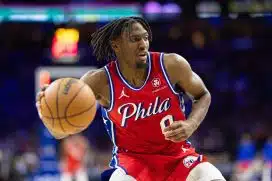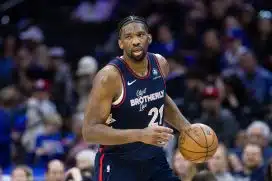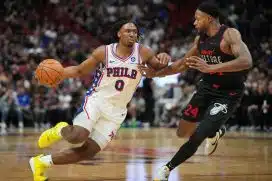By: Jesse Larch, Sports Talk Philly editor
You could say that Brett Brown drew the short straw when he agreed to become the head coach of the Philadelphia 76ers.
He was entering a situation that was hiding nothing from him – he knew that then-general manager Sam Hinkie would be tearing down the roster and entering a rebuild that would go to lengths that others had not previously dared to.
Brown knew he was entering a losing situation when he came to Philadelphia, but the well-respected Greg Popovich understudy met the challenge with optimism while others were wary of the team's future. "Can you imagine if we can get this thing right? Really? With the culture and the history this city has and the pride and toughness this city has? I think this is a very high calculated chance," said Brown at his introductory press conference way back in 2013. "I’m grateful that they have selected me."
In 2013 Brett Brown took the reigns of a Sixers team that was built around Evan Turner, Thaddeus Young, and a newly-minted all-star point guard in Jrue Holiday. It was that core that inspired ownership to "trust the process" and take a chance on Hinkie's dramatic plan. The core of Turner, Young, and Holiday had the Sixers stuck in NBA purgatory. Every year the team would make the playoffs by the skin of their teeth or fall just short, and be rewarded with a mid-first round draft selection.
Hinkie believed that the only way to escape this circle of mediocrity was to be among the teams that select the players in the beginning of the draft and not waiting to see what table scraps fall to you in the middle of the first round. Yes, once in a while a Giannis Antetokounmpo or Kawhi Leonard fall into your lap, but that is the exception and not the rule. Knowing that the Sixers needed to select stars and not role players if they were going to be among the NBA's elite, Hinkie purged the roster, leaving Brett Brown with a roster that more closely resembled one of the G-League teams than one in the NBA.
Brown entered the fold after the Sixers best player – a 23-year old Jrue Holiday – shipped out of town for the rights to 2013 draft selection Nerlens Noel, a player that everyone in the league knew would have to miss his rookie season with an injury suffered in college. Essentially, Brett Brown watched his best player leave for nothing in return before he even coached a game in Philadelphia.
Brett Brown's first game as the head coach of the Sixers featured the starting lineup of rookie Michael Carter-Williams, James Anderson, Evan Turner, Thaddeus Young, ad Spencer Hawes. Despite having the deck stacked against him, Brown managed to get out to a 3-0 start in 2013 which included an electrifying victory on opening night against the Big Three Miami Heat that featured Chris Bosh, Dwayne Wade, and LeBron James.
With Hinkie's roster purge continuing throughout the season, Brown saw his team slip to a final record of 19-63. During that season Hinkie traded Evan Turner and serviceable backup Lavoy Allen to the Indiana Pacers for Danny Granger – who never played a game for the Sixers. Hinkie also sent starting center Spencer Hawes to the Cleveland Cavaliers just hours apart from the Turner trade.
Despite all of this turnover, the Sixers still were surrounded by a sense of optimism after Brown coached Michael Carter-Williams to the NBA's Rookie of the Year award after he was able to feature the Syracuse alumnus heavily due to the depleted roster.
The next season saw Brown's patience tested again. The Sixers had two first round picks, and they used them on two players who are now highly valuable contributors to the Sixers roster, but at the time were large question marks. The Sixers left the 2014 first round with center Joel Embiid and power forward Dario Saric. Embiid, like Nerlens Noel, Was going to mis shis rookie season due to season. Saric had already signed an overseas contract that prevented him from joining the Sixers for two seasons after his draft year.
For Brown, it was like waking up on Christmas and opening your presents, but having your mom tell you that you cannot remove them from their boxes until next Christmas.
After the draft Hinkie continued to deplete what value was left on the Sixers roster, waiving 2013 starter James Anderson and trading Thaddeus Young to the Minnesota Timberwolves in a three-team trade.
With Michael Carter-Williams on the shelf to start the 2014 season Brett Brown's starting lineup had none of the same names as opening night in 2013. Brown trotted out the lineup of Tony Wroten, Hollis Thompson, Chris Johnson, Nerlens Noel, and Henry Sims. Wroten, Thompson, and Sims were all backup players on the 2013 team that won 19 games. Are you starting to understanding how little Brett Brown had to work with?
The return of Carter-Williams provided a minor boost, as he was the next domino to fall in Hinkie's long-term roster construction as he was the defending Rookie of the Year was the focal point of a three-team trade involving the Phoenix Suns and Milwaukee Bucks. The Sixers traded their starting point guard, and just like with the Holliday trade, only received draft compensation in return.
The Sixers finished the 2014-15 season with a record of 18-64.
Brown once again got to add a lottery pick into the fold, as the Sixers selected center Jahlil Okafor from a Duke Blue Devils team that was fresh off of a national championship. That made three centers selected with picks no. six, three, and three in three consecutive seasons.
With A glut of centers, Brett Brown went back to work, He was without his 2014 first round picks Dario Saric and Joel Embiid for the second consecutive season as Saric remained under contract in Turkey and Embiid struggled in his recovery from a foot injury.
Brett Brown's 2015 starting lineup was his first to have names the were the same as his prior year's debuting lineup. Isaiah Caanan, Hollis Thompson, JaKarr Sampson, Nerlens Noel, and Jahlil Okafor would be the five to lead the Sixers into their first game of 2015. Noel and Thompson are the first two players to be in consecutive opening day starting lineups during the Brett Brown era.
While no dramatic trades were made during the 2015 season, the instability within the Sixers organization did not stop, as NBA Commissioner Adam Silver stepped in and intervened with the Sixers too-obvious plan to race to the bottom of the league. Silver installed Jerry Colangelo as the team's special advisor. The move prompted the resignation of Sam Hinkie, who knew that his plan had been compromised by the league, and that Colangelo's presence meant that he would not be able to see his plan through to its fullest extent. The Sixers replaced Hinkie with Colangelo's son Bryan.
In the middle of Brown's third season he suddenly had a new boss that was handpicked by the league's caretaker because he was unhappy with how the previous regime had been operating. Brown represented the previous regime, and speculation began to mount if the Colangelo's would retain Brown after his contract expired.
2015-16 was the worst season of the Brown era, with the team finishing a dismal 10-72. The silver lining? Brown's Sixers landed the first overall pick in the NBA draft and selected Ben Simmons who was expected to become one of the elite players in the NBA.
The good news kept coming for Brown in the 2016 offseason. In addition to adding Simmons, Joel Embiid was finally cleared to play basketball and Dario Saric ended his tenure in Eurpope and joined the Sixers after much speculation about his desire to come to the NBA.
With Bryan Colangelo being part of an initiative to hault the Sixers purposeful losing he signed multiple established players to assist Brown's quest for the 2016-17 season. Those players included International point guard Sergio Rodriguez, and veteran shooting guards Gerald Henderson and Jerryd Bayless.
Brown took another punch to the gut however, when Ben Simmons suffered a foot fracture during a preseason practice that ended the first overall pick's season before it ever began.
The roots of Hinkie's rebuild began to flourish alongside the veteran additions made by Colangelo. Joel Embiid played like a superstar in the making for 31 game sbefore suffering a season-ending injury. Dario Saric transformed into an impactful stretch four behind the guidance of Ersan Ilyasova, and Robert Covington and T.J. McConnell began to show signs of significant development as they continued to grow under Brown's teachings. 2016-17 also saw the departure of Nerlens Noel via trade, once again shuffling a key part of Brown's roster.
The 2016-17 season was the best of the Brown era to date with the team winning 28 games.
2017-18 continued to see the Sixers transition from cellar dwellers to a team on the rise. Colangelo packaged the plethora of valuable draft assets that Sam Hinkie stored and parlayed them into a move to the top of the 2017 draft, where the Sixers selected consensus top prospect Markelle Fultz – a player who was expected to fit in seamlessly with a returning Simmons and Embiid.
Colangelo also led the most aggressive free agency period of any season with Brown at the helm. Colangelo added sharpshooter J.J. Redick and veteran post player Amir Johnson to the roster, giving Brown two established NBA players to lean on.
Everything seemed to be falling in line for Brown, but the man appeared to be cursed. Top draft pick Markelle Fultz ended up missing the vast majority of his rookie season due to a scapular imbalance. The Sixers had seven lottery picks during Brown's first five seasons – Nerlens Noel, Michael Carter-Williams, Joel Embiid, Dario Saric, Jahlil Okafor, Ben Simmons, and Markelle Fultz. All seven of them missed considerable chunks or all of their first season due to injury (or a contractual obligation in Saric's case).
Despite the early blow, Brown still had his most complete roster since becoming an NBA head coach, and he was finally able to prove to all of his detractors that his hire was no fluke.
Brown led the Sixers to a 52-30 season along with the third seed in the Eastern Conference. The team also won their first playoff series since the 2012 season cruising to a 4-1 series victory over the Miami Heat before running into the Boston Celtics in the second round.
Brown had validation, and he heard it come from the mouth of the man who was holding all of the cards. “I think he’s taken a big step forward…," said Bryan Colangelo at the end-of-season press conferences. "…as the talent increases, as the availability of his players is more consistent, and as he can adapt and manipulate that talent, he’s doing a very good job, which is once again why we’re going to be talking about a contract extension at the appropriate time.”
Brown, for the first time since taking the Sixers coaching job, had security. The endlessly optimistic coach was rewarded for his patience and performance with a contract extension that will allow him be the head coach of the Sixers through the 2021-2 season.
The brief moment of stability did not last for Brown, however. The man that deemed him worthy of the team's head coaching job found himself in the middle of one of the strangest storylines that the NBA may have ever seen. Bryan Colangelo was linked to a group of anonymous twitter accounts that included frequent tweets discussed the Sixers in ways that appeared to be from an informed voice, and at times leaking confidential team information about player injuries, behavior, and transactions.
The Sixers held an internal investigation into Bryan Colangelo and his family. The investigation concluded and resulted in Colangelo offering his resignation as the team's president of basketball operations after it was deemed that the tweets were coming from Colangelo's wife, although the Sixers believed that he was unaware of his wife's actions. The optics were so bad that Colangelo was left no choice but to leave the team.
With Colangelo's dismissal, Brown was elevated into an interim role that places him in charge of the team's personnel decision until a replacement for Colangelo is named, further complicating his tenure with the team. That is where we stand today.
To recap, 69 players have played for the Sixers since Brett Brown took over five season ago. He has withstood two regimes, constant roster fluctuation, poor communication from his superiors, and criticisms that were completely unwarranted given the situation that he was placed in.
The only thing that the Sixers have been able to count on over the last five seasons is that Brett Brown would show up with a good attitude and a strong commitment to the program. He has managed to overcome unprecedented odds to build what looks like the beginnings of a long culture of winning. From the ashes of the process he has risen, and with him so have the Sixers.
Now with the Sixers organization dealt a curveball that not even Aaron Nola could throw at them, the organization is leaning on the one man who has been the ultimate representation of stability.
With all that the Sixers have endured over the last five seasons, it is frightening to wonder where this team would be without Brett Brown's guidance and leadership. Now they will need it more than ever, and you can bet that Brown will once again answer the call.

